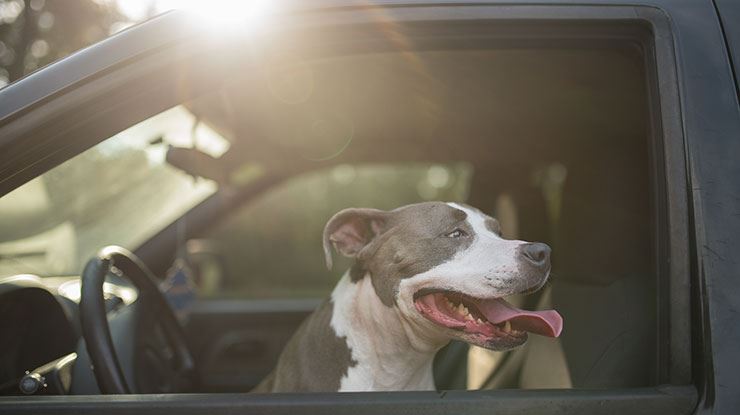
5 Tips for Handling a Veterinary Emergency While on the Road
To many of us, pets are more than loyal friends—they’re family. When you travel with your dog, it can be highly stressful for both of you, especially if he gets sick.
Accidents or illnesses that require a vet visit are hard enough when you’re at home, it can be more complicated if you’re traveling. If you plan on taking a trip with your four-legged family members, there's some advice you’ll want to remember to keep your fur babies safely in tow.
Before you decide to bring your dog along for your holiday trip, consider whether traveling will be safe for him. If your dog is old, sick, or doesn’t travel well, he may not be up to the task. If this is the case, consider letting him rest in a pet hotel, a boarding facility, or with a trusted pet sitter.
Over the years, our family has made plenty of trips to the veterinarian. It’s amazing how planning in advance can reduce a lot of stress. Hopefully you won’t ever need to use them, but these five tips will give you peace of mind if you decide to travel with your dog.
Prepare a List of Emergency Vets along Your Route
If you’re driving to your destination, you should prepare a list of nearby vet urgent and emergency care centers along your route, as well as in the area where you will be staying.
When you’re traveling, you’ll want to research the veterinary hospitals, and make note of their location and hours. If you’re planning a road trip, there are pet friendly road trip planners that make it easy to locate veterinarians along your route, saving you time when each minute counts.
Don’t forget to bring your current veterinarian’s contact information and fax number. The attending vet may have questions for your regular vet, or there may be follow up reports and instructions. Providing the contact information will save time that could be dedicated to your pet’s care.
Important Documents You Need to Bring
Pet insurance may be something you consider buying if you don’t already have your fur baby covered. Before you leave, you should notify your veterinarian. Be sure to make copies of these important documents:
- Medical records, including preexisting conditions and medications (especially when moving or traveling abroad). For U.S travel, a brief summary of medical conditions would be enough.
- Certificate of Veterinary Inspection (health certificate), this includes proof of vaccinations (rabies required) and other illnesses. This requires the examination by a licensed and accredited veterinarian to make sure the animal isn’t showing signs of disease.
- Acclimation certificate for air travel, this is required by some airlines and you should check to see if your airline requires this.
Be sure your pet has their tag with your name, current home address and home phone number. You should purchase a special travel ID tag that includes your local contact phone number and address, as well as contact information for your accommodations (hotel, campground, etc.).
You should consider having a microchip implanted before traveling with your pet. Microchips improve the chances that you’ll find your dog again if he happens to wonder off somewhere along the way.
If your pet is already microchipped, then make sure the information is up to date with the most recent contact information, including a cellphone number, before the trip.
Pet Travel Bags are Necessary
Having a good first aid kit can come in handy. You’ll have everything you need to deal with minor cuts, splinters, and upset stomachs. You should become familiar with your kit; knowing the contents and the basic first aid procedures before you need them will save time.
You should have a conversation with your vet about proper dosages for common medications (such as antihistamine or aspirin) that your pet may need while out of town.
Your pet friendly travel kit should include some obvious and some less obvious things, such as:
- Bowls
- Food
- Leashes
- Waste scoop
- Plastic bags
- Grooming supplies
- Muzzle (if you feel your pet needs one when under stress)
- Medications
- First-aid kit
- Travel documents
Also, bring water from home, either bottled or tap. Drinking water from an area where your pet isn’t used to consuming it could result in an upset stomach.
Prepare Your Pet for Vacation
If your pet isn’t used to traveling, then it’s recommended that you take your pet on short car trips before he goes on a long one. Taking your four-legged family member to a nearby park via the car should make him more comfortable with long travel.
You should make your pet as comfortable as possible with a harness and crate. The harness will keep both you and your pet safer by securing him in the car. You don’t want to take your eyes off the road to deal with a seat hopping dog.
Having a muzzle that your dog is relaxed with might be necessary. Many emergency hospitals won’t allow you to be with your pet in the exam area. Some dogs, while in pain and in an unfamiliar setting surrounded by strangers, may react poorly. If wearing a muzzle is needed for the safety of the staff, then having your dog used to wearing the muzzle will help reduce his stress.
While traveling, if it’s likely your dog will spend more time inside of a crate than he’s used to, have him spend some time in the crate in the days before to get acclimated.
The crate should have the below information written on it:
- Live animal
- Name
- Cell phone number
- Destination phone number
- Destination Address
- Home Address
- A photo of your pet
- Any health issues or current medications
- Number to primary veterinarian
You should also carry a photo of your dog with your while you travel.
If your dog is more comfortable in a certain bed with certain blankets, then bring them. Your dog loves being home, you can make traveling feel home-like for them. Bring their favorite toys and stick to a similar routine while you're on the road.
There are some dogs that shouldn’t travel by air. The American Humane Association recommends that puppies, sick or pregnant dogs, and dogs in heat shouldn’t fly. In addition, breeds with pushed-in faces known as brachycephalic breeds, such as pugs or bulldogs, shouldn’t fly.
Personal Go-Bag
Keeping a small ready-to-go bag that can be grabbed if you’re running out in a hurry is a great idea. This is super beneficial, even when you’re not traveling. It’s proactive to have one together at all times.
It’s especially helpful when you’re traveling, though. You don’t want to dig through luggage to find a medical record.
In my quick bag I keep:
- Records scanned onto a USB drive, this way the information can be easily read by the attending vet
- The names and dosages of all medications and supplements, including the time administered
- The regular vet’s telephone and fax number
- Dog treats
- Water
In an emergency, the primary concern is the amount of time it would take to get your dog the help he needs. If you reduce that time by planning ahead, you could possibly save the life of your dog. Putting a plan in place before you need it is the best way to be sure you’re giving your dog the best possible care.
Author Bio:
Lindsay Engle is the pet expert columnist for a senior healthcare resource center. Lindsay loves working in the senior healthcare industry and writing about the many benefits pets offer to elders. Aside from her job, she has a great passion for animals and loves boating. In her spare time, she enjoys snuggling on the couch with her pets as well as fishing with her boyfriend.










